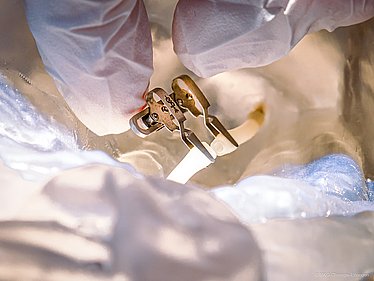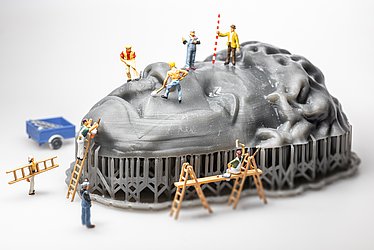Tumour surgery
Generally speaking benign tumours are differentiated from malign ones and the diagnostic backup results in differentiated treatment schemes.
Benign tumours
Benign tumours in the oral and cranio-maxillofacial area are mostly slowly growing occurrence of the skin, the mucosa, the subcutaneous tissue and the bone, which can be troublesome by their expanding growth regarding aesthetics, but also function. Benign tumours do not produce metastases, but can turn into malign tumours in individual cases in the course of time.
In any case, the histological diagnostic backup by biopsies or complete tumour removal is indispensable.
Malign tumours
The causes for malign tumours in the oral cavity (oral squamous cell carcinoma) are often the consumption of nicotine by smoke of cigarettes, above all in combination with alcohol. They are not only differentiated by crowding, but also by destroying and infiltrating growth into neighbouring tissues with the development of metastases, mostly into the cervical lymph nodes.
The treatment concept is based on the previous comprehensive diagnostics which combines the possible treatment schemes depending on the findings at their best for our patients. Every individual patient case is discussed in our interdisciplinary tumour board according to the latest guidelines.
Besides surgical options also treatment approaches with medication and/or radiotherapeutic schemes are available. Highest priority in the treatment of a malign tumour is its complete removal and, if necessary, cervical lymph node removal. The arising tissue defect can be filled with suitable local or free microvascular grafts (plastic-reconstructive surgery). The main goal is always the complete removal of the malign tumours under functional maintenance of the maxillofacial area.
Following inpatient treatment regular inpatient follow-up is done over years (tumour follow-up care), to discover possible recurrence of the tumour (recurrence) or development of a secondary tumour at an early stage.
Plastic reconstructive surgery

The goal of plastic-reconstructive surgery is the next-to-perfect rehabilitation of function and aesthetics of tissue which was destroyed by trauma or tumour growth.
In minor defects, reconstruction is often possible by relocation of the neighbouring tissues, so-called local advanced flaps. As an alternative, those defects can be reconstructed by distant flaps, tissue from more distant areas. The advantage of these techniques is that colour and texture of the skin are similar to the original defect.
When defects which have been caused by trauma or tumours extend a certain size or they are situated in an area which cannot be reconstructed by the beforementioned techniques, there is still the option to put free tissue flaps from other areas of the body, such as from the upper arm, the lower arm or from the back, with grating these flaps with the feeding blood vessels. To safeguard the feeding of the individual graft, blood vessels (arteries and veins) are connected by microsurgical techniques, mostly in neck vessels to the patient’s circulation.
For the reconstruction of the bony defects combined soft tissue and bone grafts from fibula, scapula or straight bony grafts from the iliac crest are available.
Modern foreign materials of artificial or partially animal origin for the temporary or definite reconstruction of defects have additionally been available. However, autogenous bone grafts are considered to be the best for hard and soft tissue replacement in most cases.
Interdisciplinary cleft lip and palate centre (CLP Centre)

Cleft lip and/or palate are one of the most common congenital malformations in human beings. In Germany about one out of 500 to 700 babies are born with such a malformation. They arise very early between the sixth and twelfth embryonal week. According to their extent cleft malformations are divided into isolated cleft lip and palate (CLP) and their combinations among them. They can be unilateral or bilateral formations.
Parents and relatives receive rich information already before the child is born. After birth, a comprehensive interdisciplinary treatment concept will be individually designed by the teams of oral and cranio-maxillofacial surgery, orthodontics, ENT, paediatrics, phoniatrics and speech therapy (logopaedics). Right from the beginning the young patients and their relatives are being closely linked to our clinic and regular follow-ups in our consultation hours for cleft lip and palate patients will be scheduled. The Department of Oral and Cranio-Maxillofacial Surgery is part of the regional centre for the treatment and care of patients with CLP and their relatives. As a rule, surgical treatment already starts in the first year of life. They type of surgery depends on the individual cleft formation and is mostly consists of an initial lip closure (lip-plasty) and if necessary closure of the palate (palatoplasty). Further surgical interventions take place in the long run and as corrections at infants’ age and in early childhood/young adults’ age.



